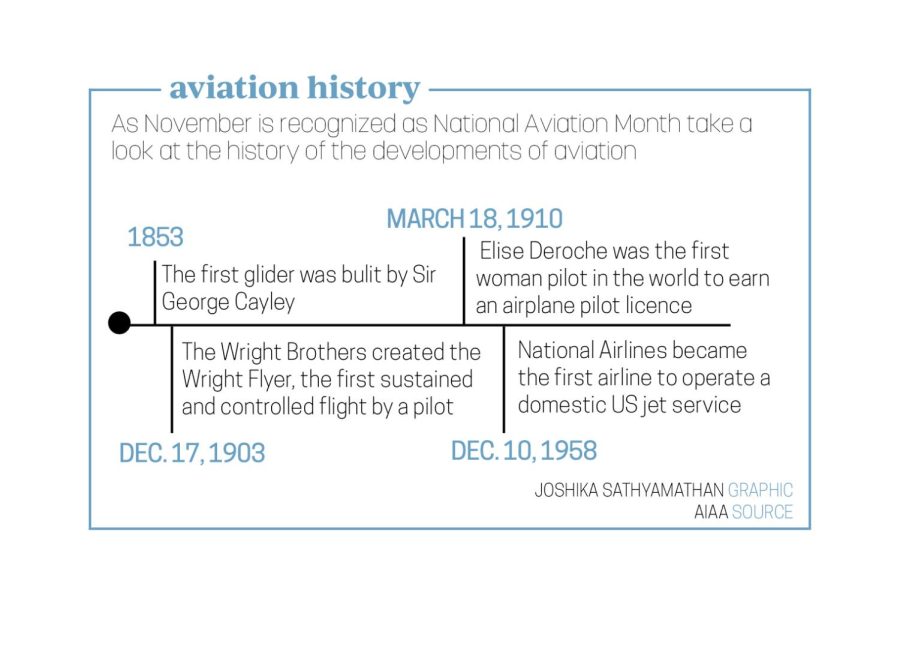Junior Cameron Ice’s interest in aviation began when he was a kid. Now, he has more than 40 hours of flight time.
He said, “My dad pursued aviation and it always interested me as a young kid. On my 14th birthday, my dad took me to the airport because he had scheduled a discovery flight. It is still one of the best gifts I’ve ever received.”
Sarvagh Shrianandh, Aerospace club president and senior, said he also became interested in aviation as a young child, but unlike Ice, he hasn’t had any training experience.
“I took my first flight when I was 4 years old. Since then, my inherent interest in aviation has never stopped growing,” Shrianandh said. “The enthusiasm for aviation that I have has been the primary factor of my interest, and I want to continue to expand on that as I go into college.”
As the 119th anniversary of the first flight by the Wright brothers comes up on Dec. 17, California Aeronautical University said in an article titled “The Biggest Breakthroughs in Aviation History, Part II” aircraft advancements, including jet engines, radar and cabin pressurization, have caused increased feelings of safety and reliance on planes.
Ice said these advancements have caused him to feel comfortable flying a plane without any doubts about the aircraft itself.
“The scariest thing that could happen is a crash, but the probability of a crash happening is slim to none. Even if you get in a situation that could be remotely dangerous, pilots are trained to handle such things,” Ice said. “More than 90% of crashes are due to human error. The plane is almost never at fault and they are extremely reliable and shouldn’t be feared.”
Aerospace engineering teacher, Zachary Bonewit, agrees with Ice. However, he has a different reasoning because he’s never gone through pilot training.
“I grew up drag racing, driving various different types of cars. In drag racing, efficiency and consistency are the foundation of success, which is the same as aerospace,” Bonewit said. “(During flight,) I have trust issues with the pilots. Even though I took risks and drove at high speeds while racing, I always felt like I was in control of the outcome.”
Although planes have become safer and more reliable throughout the years, Ice said he still has had some scary moments while going through pilot training.
“One (story) that stood out to me was the time I had a bird strike. Bird strikes can be extremely dangerous. As soon as I got off the ground and looked out in front of me, I saw a goose take off vertically off the runway,” Ice said. “Unfortunately, the bird was dead, but I was extremely lucky that the bird didn’t hit my prop or windshield which could’ve caused major damage and a potential crash.”
To continue the progress of plane development, and eliminate Ice’s worry about bird strikes, Bonewit said participation in the aerospace industry is crucial.
He said, “There has never been a better time to enter the aerospace industry. It doesn’t matter if you are interested in aerospace engineering, becoming a pilot or working on projects to send humans back to the moon or even to Mars.”




























![Keep the New Gloves: Fighter Safety Is Non-Negotiable [opinion]](https://hilite.org/wp-content/uploads/2024/12/ufcglovescolumncover-1200x471.png)






!["Wicked" poster controversy sparks a debate about the importance of accuracy versus artistic freedom [opinion]](https://hilite.org/wp-content/uploads/2024/11/riva-perspective-cover-1200x471.jpg)









































![Review: “We Live in Time” leaves you wanting more [MUSE]](https://hilite.org/wp-content/uploads/2024/12/IMG_6358.jpg)
![Review: The premise of "Culinary Class Wars" is refreshingly unique and deserving of more attention [MUSE]](https://hilite.org/wp-content/uploads/2024/12/MUSE-class-wars-cover-2.png)
![Introducing: "The Muses Who Stole Christmas," a collection of reviews for you to follow through winter [MUSE]](https://hilite.org/wp-content/uploads/2024/12/winter-muse-4.gif)
![Review: "Meet Me Next Christmas" is a cheesy and predictable watch, but it was worth every minute [MUSE]](https://hilite.org/wp-content/uploads/2024/11/AAAAQVfRG2gwEuLhXTGm3856HuX2MTNs31Ok7fGgIVCoZbyeugVs1F4DZs-DgP0XadTDrnXHlbQo4DerjRXand9H1JKPM06cENmLl2RsINud2DMqIHzpXFS2n4zOkL3dr5m5i0nIVb3Cu3ataT_W2zGeDAJNd_E-1200x884.jpg)
![Review: "Gilmore Girls", the perfect fall show [MUSE]](https://hilite.org/wp-content/uploads/2024/11/gilmore-girls.png)
![Review in Print: Maripaz Villar brings a delightfully unique style to the world of WEBTOON [MUSE]](https://hilite.org/wp-content/uploads/2023/12/maripazcover-1200x960.jpg)
![Review: “The Sword of Kaigen” is a masterpiece [MUSE]](https://hilite.org/wp-content/uploads/2023/11/Screenshot-2023-11-26-201051.png)
![Review: Gateron Oil Kings, great linear switches, okay price [MUSE]](https://hilite.org/wp-content/uploads/2023/11/Screenshot-2023-11-26-200553.png)
![Review: “A Haunting in Venice” is a significant improvement from other Agatha Christie adaptations [MUSE]](https://hilite.org/wp-content/uploads/2023/11/e7ee2938a6d422669771bce6d8088521.jpg)
![Review: A Thanksgiving story from elementary school, still just as interesting [MUSE]](https://hilite.org/wp-content/uploads/2023/11/Screenshot-2023-11-26-195514-987x1200.png)
![Review: "When I Fly Towards You", cute, uplifting youth drama [MUSE]](https://hilite.org/wp-content/uploads/2023/09/When-I-Fly-Towards-You-Chinese-drama.png)
![Postcards from Muse: Hawaii Travel Diary [MUSE]](https://hilite.org/wp-content/uploads/2023/09/My-project-1-1200x1200.jpg)
![Review: "Ladybug & Cat Noir: The Movie," departure from original show [MUSE]](https://hilite.org/wp-content/uploads/2023/09/Ladybug__Cat_Noir_-_The_Movie_poster.jpg)
![Review in Print: "Hidden Love" is the cute, uplifting drama everyone needs [MUSE]](https://hilite.org/wp-content/uploads/2023/09/hiddenlovecover-e1693597208225-1030x1200.png)
![Review in Print: "Heartstopper" is the heartwarming queer romance we all need [MUSE]](https://hilite.org/wp-content/uploads/2023/08/museheartstoppercover-1200x654.png)




